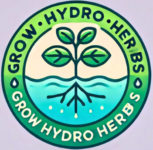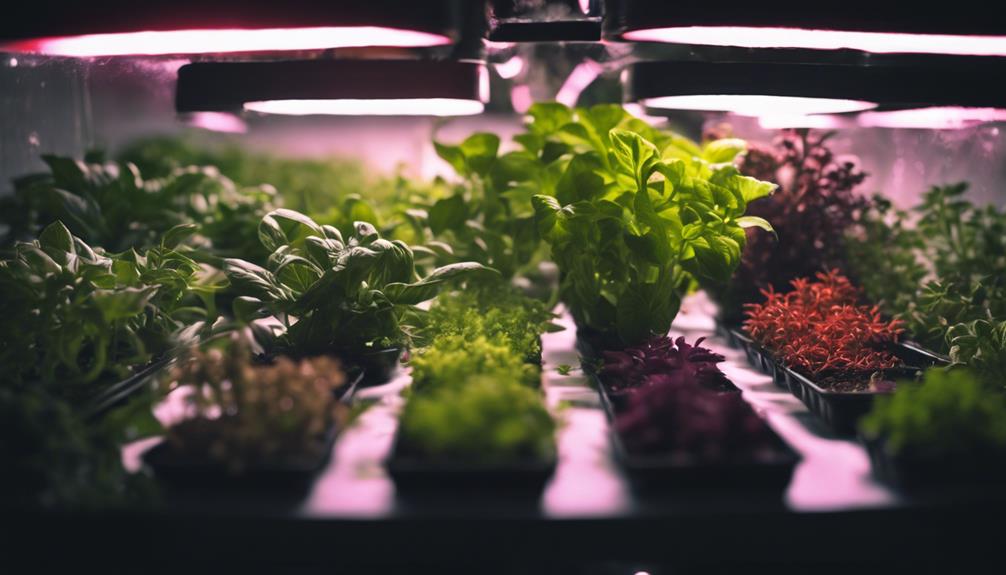Optimize light coverage in hydroponic systems
Prioritizing factors like light intensity, spectrum, and placement. Guarantee adequate light hours during growth stages. Adjust light height for uniform distribution.
Utilize reflective surfaces and supplemental lighting if needed. Tailor light spectrum to match plant requirements. Use blue light for vegetative growth and red light for flowering. Monitoring and adjusting these factors enhance photosynthesis, nutrient absorption, and overall plant health.
Mastering light optimization techniques can maximize plant growth. It can help you achieve success in your hydroponic setup.
GrowHydroHerbs TLDR
- Position lights strategically for even coverage and optimal plant exposure.
- Utilize reflectors to enhance light distribution and minimize shadowed areas.
- Adjust light height to maintain uniform intensity across plants.
- Incorporate supplemental lighting to address dark spots and ensure complete coverage.
- Choose lights with tailored spectra to match plant growth stages and maximize growth potential.
What is Light Coverage?
Light coverage refers to the area that a grow light can effectively illuminate in a hydroponic system. It is a critical factor in ensuring that all plants receive adequate light for optimal growth. Proper light coverage ensures that light is evenly distributed across the entire growing area. It minimizes dark spots and shadows that can hinder plant development.
Several factors influence light coverage. These including the type of grow light, its wattage, and the distance between the light and the plants. Higher-wattage lights typically cover larger areas. This reduces the number of lights needed for a given space. The positioning and height of the lights also play a crucial role in maintaining uniform light intensity across all plants.

(click to expand)
Effective light coverage ensures each plant in the hydroponic system receives sufficient light for photosynthesis. This leads to better growth and higher yields.
Use reflectors and strategically place supplemental lights. This can help enhance light distribution and coverage.
What are the Light Requirements for Hydroponic Plants?
Your hydroponic plants require adequate light throughout their growth cycle. Light intensity is essential for photosynthesis. Photosynthesis is the process by which plants convert light into energy for growth. Insufficient light intensity can lead to stunted growth and poor yields.
It’s recommended to provide your plants with the appropriate light intensity. Light intensity is typically measured in lumens or lux. The requirements are based on the specific requirements of the plant species you’re growing.
In addition to light intensity, light duration also plays an important role in the growth of your hydroponic plants. Most plants require around 14-16 hours of light per day during their vegetative stage and 8-12 hours during their flowering stage.
Provide the correct amount of light duration. This ensures that your plants receive adequate energy for their growth and development.
Placement of Grow Lights
Proper placement of grow lights guarantees ideal light coverage and distribution for your hydroponic plants. Consider the spacing between each light. This ensures uniform light distribution across all plants.
Adjust the height of the lights based on the specific light intensity requirements of your plant species. Make sure the duration of light exposure aligns with the needs of your plants. This provides them with the right amount of light for best growth.
Here are five key considerations for effectively placing your grow lights:
- Consider Light Positioning. Place the grow lights strategically to cover all plants evenly.
- Optimize Spacing. Ensure proper distance between lights to avoid overexposure or underexposure.
- Adjust Light Intensity. Tailor the light intensity to match the requirements of your plants.
- Manage Light Duration. Control the duration of light exposure to meet the needs of different plant growth stages.
- Monitor Light Distribution. Regularly assess the coverage and adjust positioning as needed to maximize plant growth.
Importance of Light Spectrum

Ensuring the correct light spectrum is important for ideal plant growth and development. The light spectrum plays a significant role in light intensity. Light intensity directly impacts plant health and nutrient absorption. Different wavelengths of light are absorbed by plants. This fuels photosynthesis at various growth stages. Blue light promotes vegetative growth. Red light encourages flowering and fruiting.
By providing the appropriate light spectrum, you can optimize the photosynthetic process. This leads to healthier and more robust plants.
Consider the table below to understand the relationship between light spectrum and plant growth:
| Light Spectrum | Impact on Plant Growth |
|---|---|
| Blue Light | Enhances vegetative growth |
| Red Light | Stimulates flowering and fruiting |
| Full Spectrum | Supports overall plant development |
| UV Light | Aids in stress response mechanisms |
Maximizing Light Coverage Techniques
Strategically position and adjust your lights is essential to maximize light coverage.
To guarantee maximum light distribution and intensity, consider the following techniques:
- Adjusting Height. Raise or lower your lights to maintain an ideal distance from your plants. Thus, ensuring uniform coverage.
- Using Reflectors. Install reflectors around your lights to bounce and direct light towards plants. This increases coverage efficiency.
- Rotating Plants. Regularly rotate your plants to expose all sides evenly to the light source. This prevents shadowed areas.
- Supplemental Lighting. Incorporate additional lights strategically to fill in any dark spots. This also enhances overall coverage.
- Light Spectrum. Choose lights with a spectrum tailored to your plant’s needs. Thus, maximizing light intensity for growth.
Enhancing Plant Growth With Light

Enhancing plant growth with light involves strategically optimizing the light exposure your plants receive in your hydroponic system. Light intensity plays an important role in the photosynthesis process. Thereby directly impacting plant growth.
Make sure your plants receive adequate light intensity. That will promote healthy development and robust yields.
Additionally, light duration is essential for proper nutrient absorption. Provide your plants with the right amount of light for the appropriate duration. This ensures they can effectively take in essential nutrients. Thus, contributing to their overall health and vitality.
Consider using grow lights with adjustable settings to control both intensity and duration. Monitoring and adjusting these factors based on the specific needs of your plants can greatly impact their growth rates and overall success in a hydroponic system.
What Did We Learn About Light Coverage in Hydroponic Systems?
Implement techniques to enhance light coverage. This will boost plant growth and overall productivity. Do the following to maximize the efficiency of your hydroponic setup:
- Optimizing light coverage in hydroponic systems ensures ideal plant growth and yield.
- Understand the light requirements of your specific plants.
- Strategically placing grow lights
- Utilize the right light spectrum,
Remember, proper lighting is key to success in hydroponic gardening.


